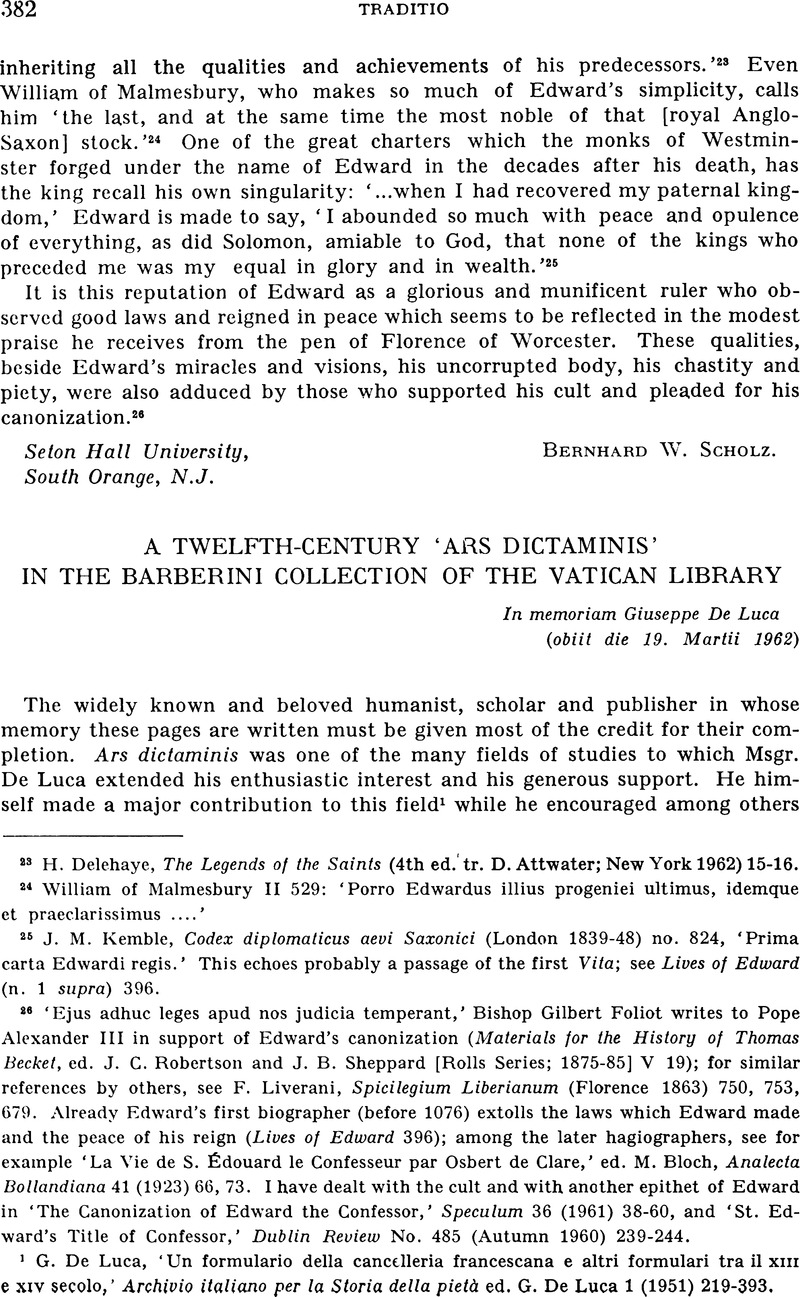Published online by Cambridge University Press: 17 July 2017

1 De Luca, G., ‘Un formulario della cancelleria francescana e altri formulari tra il xin e xiv secolo,‘ Archivio italiano per la Storia della pietà ed. De Luca, G. 1 (1951) 219–393.Google Scholar
1a On this date see below, 384f. Because of lack of information the dictator may have chosen the month of April just at randon (see also Letter 18), or he may have been told a later date of the Emperor's arrival and the assembly at Roncaglia, which was actually held in 1154, December 3.Google Scholar
2 See Simonsfeld, H., Jahrbücher des Deutschen Reiches unter Friedrich I. (Leipzig 1908) I 434–40, 452-4. On the ancient custom of sending emissaries ahead of an imperial army and on the Diet of Roncaglia of December 1154, see Otto of Freising, Gesta Friderici 2.15 and 2.12.Google Scholar
3 On the political career of Guido Guerra II see R. Davidsohn, Geschichte von Florenz (Berlin 1896–1927) I 420-21, 446-54.Google Scholar
4 See Simonsfeld op. cit. I 252 and passim.Google Scholar
5 In 1136, at the time of Lothaire's arrival in Italy, Count Guido Guerra II, who had just succeeded his father, opposed the advance of the imperial army under Duke Henry of Bavaria, see Davisohn I 420-21. It was not before 1148 that the general situation in Tuscany caused him to shift to the imperial side. In 1158, on the other hand, when Barbarossa crossed the Alps for the second time and assembled his second Diet at Roncaglia, Count Guido Guerra was dead (d. 1157) and his young son, the later Guido Guerra III, was still a minor, ibid. 464.Google Scholar
6 The Conteguidi, who played such a prominent part in the history of Florence, originally hailed from the Romagna. The German kings endowed them with land and powers in the Sieve and Arno river valleys, thus transplanting them to Tuscany; see Davidsohn 106.Google Scholar
7 It is perhaps safe to identify the writer of Letter 18 with the young Count Albert of Prato who in June 1155 received a privilege from Frederic Barbarossa; see Simonsfeld I 317.Google Scholar
8 See Haskins, Ch. H., ‘The early Arles dictandi in Italy,’ Sludies in Mediaeval Culture (New York 1929) 188 and passim.Google Scholar
9 The view that ars dictaminis began with Alberic of Montecassino and his Breviarium de dictamine, held until very recently, is by now outdated. After Haskins, who had already modified it (op. cit. 172-3), F.J. Schmale has recently shown that the true founder of the epistolary doctrine was Albert or Adalbert of Samaria, who tought at Bologna in the second decade of the twelfth century; see Adalberlus Samarilanus, Praecepta dictaminum, ed. F. J. Schmale (MGH, Quellen zur Geistesgeschichte des Mittelalters 3; Weimar 1961) Introd. 2-4, 9-11. Adalbert's work appears to have been a definite departure from the Ciceronian trend of Alberic's teaching. It marked the beginning of a new pratical instruction in the art as detached from the cathedral schools and tought by lay teachers mainly to laymen.Google Scholar
10 See Schmale, op. cit 17-20. The Barberini dictator may or may not have used the Praecepta dictaminum in its original version. At any rate, in one of his exordia he paraphrases an example for a certain type of letters found in Adalbert's work: see Letter 10 n. 1.Google Scholar
11 Although it was anticipated at least in part by some earlier Arles, the division of the letter in five parts was laid down as an ironclad rule of ars dictaminis in the anonymous Rationes dictandi written after 1140 in Northern Italy (formerly attributed to Alberic of Montecassino), see Schmale, op. cit. 2. For specialized studies on this subject see A. Bütow Die Entwicklung der mittelalterlichen Briefsteller bis zur Mitte des 12. Jahrhunderts (Greifswald 1908) and the literature listed in Haskins, ‘Letters of Mediaeval Students,’ Studies in Mediaeval Culture 1-3.Google Scholar
12 The student letters follow the conventional patterns worked out at many schools and in all parts of Europe at this time, their language and style being primarily determined by their usefulness in serving the students’ own direct needs, such as extracting money from reluctant parents and relatives. See Haskins, op. cit. 1-35. In the correspondence between two lovers (Letters 14, 15) on the other hand, the dictator replaces the traditional and formal De Amasio ad Amasiam type (Haskins 31) with dictamina marked by a more sophisticated and literary expression for the lovers’ feelings. — The balance of the collection is made up by five political letters (12, 13, 16-18) and two of a rather non-descript moralizing content (Letters 10, 11).Google Scholar
13 See C. Sutter, Aus Leben und Schriften des Magister Boncompagno (Freiburg 1894) ch. 4. When attacking what he called ‘the erroneous and superstitious doctrine of Orléans,’ Boncompagno aimed first of all at the traditional French way of quoting from classical authors. See Sutter, op. cit. 38; H. Wieruszowski, ‘Arezzo as a Center of Learning and Letters in the Thirteenth Century,’ Traditio 9 (1953) 351-354.Google Scholar
14 They are characterized in the article mentioned in the preceding note (351-374) and in H. Wierruszowski, ‘Ars dictaminis in the time of Dante,’ Medievalia et Humanistica 1 (1944) 95-108. For the older type, which excels in form letters for the correspondence of emperors, kings and popes, cf. the Introductions prosaici dictaminis of Bernard of Bologna (c. 1145) in H. Kalbfuss, ‘Eine Bologneser Ars dictandi des XII. Jahrhunderts’ Quellen und Forschungen aus italienischen Archiven und Bibliotheken 16 (914) 1-35.Google Scholar
15